Application of Different Indices for Soil Heavy Metal Pollution Risk Assessment Comparison and Uncertainty: A Case Study of a Copper Mine Tailing Site
Abstract
:1. Introduction
2. Materials and Methods
2.1. Study Area
2.2. Sample Collection and Treatment
2.3. Methods of Pollution Assessment
2.3.1. Pollution Index
2.3.2. Geological Accumulation Index
2.3.3. The Nemerow Index
2.3.4. Ecological Risk Index
2.3.5. Health Risk Index
2.4. Methods of Pollution Assessment
3. Results
3.1. Descriptive Statistics of Heavy Metal Concentrate in Soil
3.2. Evaluation Results of Different Indices
3.3. Comparison of Different Evaluation Indices
4. Discussion
5. Conclusions
Author Contributions
Funding
Data Availability Statement
Acknowledgments
Conflicts of Interest
References
- Solgi, E.; Esmaili-Sari, A.; Riyahi-Bakhtiari, A.; Hadipour, M. Soil Contamination of Metals in the Three Industrial Estates, Arak, Iran. Bull. Environ. Contam. Toxicol. 2012, 88, 634–638. [Google Scholar] [CrossRef] [PubMed]
- Zhao, X.; Huang, J.; Lu, J.; Sun, Y. Study on the influence of soil microbial community on the long-term heavy metal pollution of different land use types and depth layers in mine. Ecotoxicol. Environ. Saf. 2019, 170, 218–226. [Google Scholar] [CrossRef] [PubMed]
- Liu, B.; Ai, S.; Zhang, W.; Huang, D.; Zhang, Y. Assessment of the bioavailability, bioaccessibility and transfer of heavy metals in the soil-grain-human systems near a mining and smelting area in NW China. Sci. Total Environ. 2017, 609, 822–829. [Google Scholar] [CrossRef] [PubMed]
- Jamshidi-Zanjani, A.; Saeedi, M. Multivariate analysis and geochemical approach for assessment of metal pollution state in sediment cores. Environ. Sci. Pollut. Res. 2017, 24, 16289–16304. [Google Scholar] [CrossRef] [PubMed]
- Arabyarmohammadi, H.; Darban, A.K.; Abdollahy, M.; Yong, R.; Ayati, B.; Zirakjou, A.; van der Zee, S.E.A.T. Utilization of a Novel Chitosan/Clay/Biochar Nanobiocomposite for Immobilization of Heavy Metals in Acid Soil Environment. J. Polym. Environ. 2018, 26, 2107–2119. [Google Scholar] [CrossRef]
- Lashen, Z.M.; Shams, M.S.; El-Sheshtawy, H.S.; Slany, M.; Antoniadis, V.; Yang, X.; Sharma, G.; Rinklebe, J.; Shaheen, S.M.; Elmahdy, S.M. Remediation of Cd and Cu contaminated water and soil using novel nanomaterials derived from sugar beet processing- and clay brick factory-solid wastes. J. Hazard. Mater. 2022, 428, 128205. [Google Scholar] [CrossRef]
- Zhang, X.; Yang, H.; Cui, Z. Evaluation and analysis of soil migration and distribution characteristics of heavy metals in iron tailings. J. Clean. Prod. 2018, 172, 475–480. [Google Scholar] [CrossRef]
- Huang, J.; Guo, S.; Zeng, G.; Li, F.; Gu, Y.; Shi, Y.; Shi, L.; Liu, W.; Peng, S. A new exploration of health risk assessment quantification from sources of soil heavy metals under different land use. Environ. Pollut. 2018, 243, 49–58. [Google Scholar] [CrossRef]
- Patra, D.K.; Acharya, S.; Pradhan, C.; Patra, H.K. Poaceae plants as potential phytoremediators of heavy metals and eco-restoration in contaminated mining sites. Environ. Technol. Innov. 2021, 21, 101293. [Google Scholar] [CrossRef]
- Shahsavari, A.; Yazdi, F.T.; Moosavi, Z.; Heidari, A.; Sardari, P. A study on the concentration of heavy metals and histopathological changes in Persian jirds (Mammals; Rodentia), affected by mining activities in an iron ore mine in Iran. Environ. Sci. Pollut. Res. Int. 2019, 26, 12590–12604. [Google Scholar] [CrossRef]
- Hanfi, M.Y.; Mostafa, M.Y.A.; Zhukovsky, M.V. Heavy metal contamination in urban surface sediments: Sources, distribution, contamination control, and remediation. Environ. Monit. Assess. 2019, 192, 32. [Google Scholar] [CrossRef] [PubMed]
- Nanos, N.; Rodriguez Martin, J.A. Multiscale analysis of heavy metal contents in soils: Spatial variability in the Duero river basin (Spain). Geoderma 2012, 189–190, 554–562. [Google Scholar] [CrossRef]
- Zhai, L.; Liao, X.; Chen, T.; Yan, X.; Xie, H.; Wu, B.; Wang, L. Regional assessment of cadmium pollution in agricultural lands and the potential health risk related to intensive mining activities: A case study in Chenzhou City, China. J. Environ. Sci. 2008, 20, 696–703. [Google Scholar] [CrossRef]
- Wu, S.; Peng, S.; Zhang, X.; Wu, D.; Luo, W.; Zhang, T.; Zhou, S.; Yang, G.; Wan, H.; Wu, L. Levels and health risk assessments of heavy metals in urban soils in Dongguan, China. J. Geochem. Explor. 2015, 148, 71–78. [Google Scholar] [CrossRef]
- Teng, Y.; Wu, J.; Lu, S.; Wang, Y.; Jiao, X.; Song, L. Soil and soil environmental quality monitoring in China: A review. Environ. Int. 2014, 69, 177–199. [Google Scholar] [CrossRef] [PubMed]
- Lv, J. Multivariate receptor models and robust geostatistics to estimate source apportionment of heavy metals in soils. Environ. Pollut. 2019, 244, 72–83. [Google Scholar] [CrossRef]
- Zhang, Q.; Wang, C. Natural and Human Factors Affect the Distribution of Soil Heavy Metal Pollution: A Review. Water Air Soil Pollut. 2020, 231, 350. [Google Scholar] [CrossRef]
- Antoniadis, V.; Shaheen, S.M.; Boersch, J.; Boersch, J.; Frohne, T.; Du Laing, G.; Rinklebe, J. Bioavailability and risk assessment of potentially toxic elements in garden edible vegetables and soils around a highly contaminated former mining area in Germany. J. Environ. Manag. 2017, 186, 192–200. [Google Scholar] [CrossRef]
- Yang, S.; Zhou, D.; Yu, H.; Wei, R.; Pan, B. Distribution and speciation of metals (Cu, Zn, Cd, and Pb) in agricultural and non-agricultural soils near a stream upriver from the Pearl River, China. Environ. Pollut. 2013, 177, 64–70. [Google Scholar] [CrossRef]
- Acosta, J.A.; Jansen, B.; Kalbitz, K.; Faz, A.; Martinez-Martinez, S. Salinity increases mobility of heavy metals in soils. Chemosphere 2011, 85, 1318–1324. [Google Scholar] [CrossRef]
- Cerqueira, B.; Covelo, E.F.; Andrade, L.; Vega, F.A. The influence of soil properties on the individual and competitive sorption and desorption of Cu and Cd. Geoderma 2011, 162, 20–26. [Google Scholar] [CrossRef]
- Hu, Z.; Wang, C.; Li, K.; Zhu, X. Distribution characteristics and pollution assessment of soil heavy metals over a typical nonferrous metal mine area in Chifeng, Inner Mongolia, China. Environ. Earth Sci. 2018, 77, 638. [Google Scholar] [CrossRef]
- Costa, M.; Henriques, B.; Pinto, J.; Fabre, E.; Viana, T.; Ferreira, N.; Amaral, J.; Vale, C.; Pinheiro-Torres, J.; Pereira, E. Influence of salinity and rare earth elements on simultaneous removal of Cd, Cr, Cu, Hg, Ni and Pb from contaminated waters by living macroalgae. Environ. Pollut. 2020, 266, 1153741. [Google Scholar] [CrossRef]
- Gong, Q.; Deng, J.; Xiang, Y.; Wang, Q.; Yang, L. Calculating pollution indices by heavy metals in ecological geochemistry assessment and a case study in parks of Beijing. J. China Univ. Geosci. 2008, 19, 230–241. [Google Scholar]
- Tan, K.; Ma, W.; Chen, L.; Wang, H.; Du, Q.; Du, P.; Yan, B.; Liu, R.; Li, H. Estimating the distribution trend of soil heavy metals in mining area from HyMap airborne hyperspectral imagery based on ensemble learning. J. Hazard. Mater. 2021, 401, 123288. [Google Scholar] [CrossRef]
- Mazurek, R.; Kowalska, J.; Gasiorek, M.; Zadrozny, P.; Jozefowska, A.; Zaleski, T.; Kepka, W.; Tymczuk, M.; Orlowska, K. Assessment of heavy metals contamination in surface layers of Roztocze National Park forest soils (SE Poland) by indices of pollution. Chemosphere 2017, 168, 839–850. [Google Scholar] [CrossRef]
- Zhang, H.M.; Zhang, H.; Song, A.; Qin, J.; Song, M. Evaluation of Ecological Risk on Soil Heavy Metals Pollution of Qingyuan. Prog. Environ. Sci. Eng. 2013, 610–613, 928–931. [Google Scholar] [CrossRef]
- Liu, L.; Li, W.; Song, W.; Guo, M. Remediation techniques for heavy metal-contaminated soils: Principles and applicability. Sci. Total Environ. 2018, 633, 206–219. [Google Scholar] [CrossRef]
- Li, S.; Wu, J.; Huo, Y.; Zhao, X.; Xue, L. Profiling multiple heavy metal contamination and bacterial communities surrounding an iron tailing pond in Northwest China. Sci. Total Environ. 2021, 752, 141827. [Google Scholar] [CrossRef]
- Wang, S.; Kalkhajeh, Y.K.; Qin, Z.; Jiao, W. Spatial distribution and assessment of the human health risks of heavy metals in a retired petrochemical industrial area, south China. Environ. Res. 2020, 188, 109661. [Google Scholar] [CrossRef]
- Christou, A.; Theologides, C.P.; Costa, C.; Kalavrouziotis, I.K.; Varnavas, S.P. Assessment of toxic heavy metals concentrations in soils and wild and cultivated plant species in Limni abandoned copper mining site, Cyprus. J. Geochem. Explor. 2017, 178, 16–22. [Google Scholar] [CrossRef]
- HJ/T 166-2004; Technical Specification for Soil Environmental Monitoring. State Environmental Protection Administration (Ministry of Ecology and Environment of the People’s Republic of China): Beijing, China, 2004.
- Aydin, F.A.; Soylak, M. A novel multi-element coprecipitation technique for separation and enrichment of metal ions in environmental samples. Talanta 2007, 73, 134–141. [Google Scholar] [CrossRef] [PubMed]
- Muller, G. Index of geoaccumulation in sediments of the Rhineriver. Geojournal 1969, 2, 108. [Google Scholar]
- Han, I.; Whitworth, K.W.; Christensen, B.; Afshar, M.; Han, H.A.; Rammah, A.; Oluwadairo, T.; Symanski, E. Heavy metal pollution of soils and risk assessment in Houston, Texas following Hurricane Harvey. Environ. Pollut. 2022, 296, 118717. [Google Scholar] [CrossRef]
- Hakanson, L. An ecological risk index for aquatic pollution control: A sedimentological approach. Water Res. 1980, 14, 975–1001. [Google Scholar] [CrossRef]
- Lu, S.; Wang, Y.; He, L. Ecological Risk of Heavy Metals on the Paddy Soils at a Village in Hunan. Enuivon. Sci. Technol. 2014, 37, 100–105, 117. [Google Scholar]
- Deng, M.; Zhu, Y.; Shao, K.; Zhang, Q.; Ye, G.; Shen, J. Metals source apportionment in farmland soil and the prediction of metal transfer in the soil-rice-human chain. J. Environ. Manag. 2020, 260, 110092. [Google Scholar] [CrossRef]
- Ben Chabchoubi, I.; Mtibaa, S.; Ksibi, M.; Hentati, O. Health risk assessment of heavy metals (Cu, Zn, and Mn) in wild oat grown in soils amended with sediment dredged from the Joumine Dam in Bizerte, Tunisia. Euro-Mediterr. J. Environ. Integr. 2020, 5, 60. [Google Scholar] [CrossRef]
- Chonokhuu, S.; Batbold, C.; Chuluunpurev, B.; Battsengel, E.; Dorjsuren, B.; Byambaa, B. Contamination and Health Risk Assessment of Heavy Metals in the Soil of Major Cities in Mongolia. Int. J. Environ. Res. Public Health 2019, 16, 2552. [Google Scholar] [CrossRef] [Green Version]
- GB/T21010-2017; Current Land Use Classification. General Administration of Quality Supervision, Inspection and Quarantine of the People’s Republic of China; Standardization Administration of the People’s Republic of China: Beijing, China, 2017.
- GB-15618-2018; Soil Environment Quality Risk Control Standard for Soil Contamination of Agriculture Land. Ministry of Ecology and Environment of the People’s Republic of China; State Administration of Market Regulation: Beijing, China, 2018.
- USEPA. Exposure Factors Handbook; General Factors; USEPA: Washington, DC, USA, 1996; Volume I.
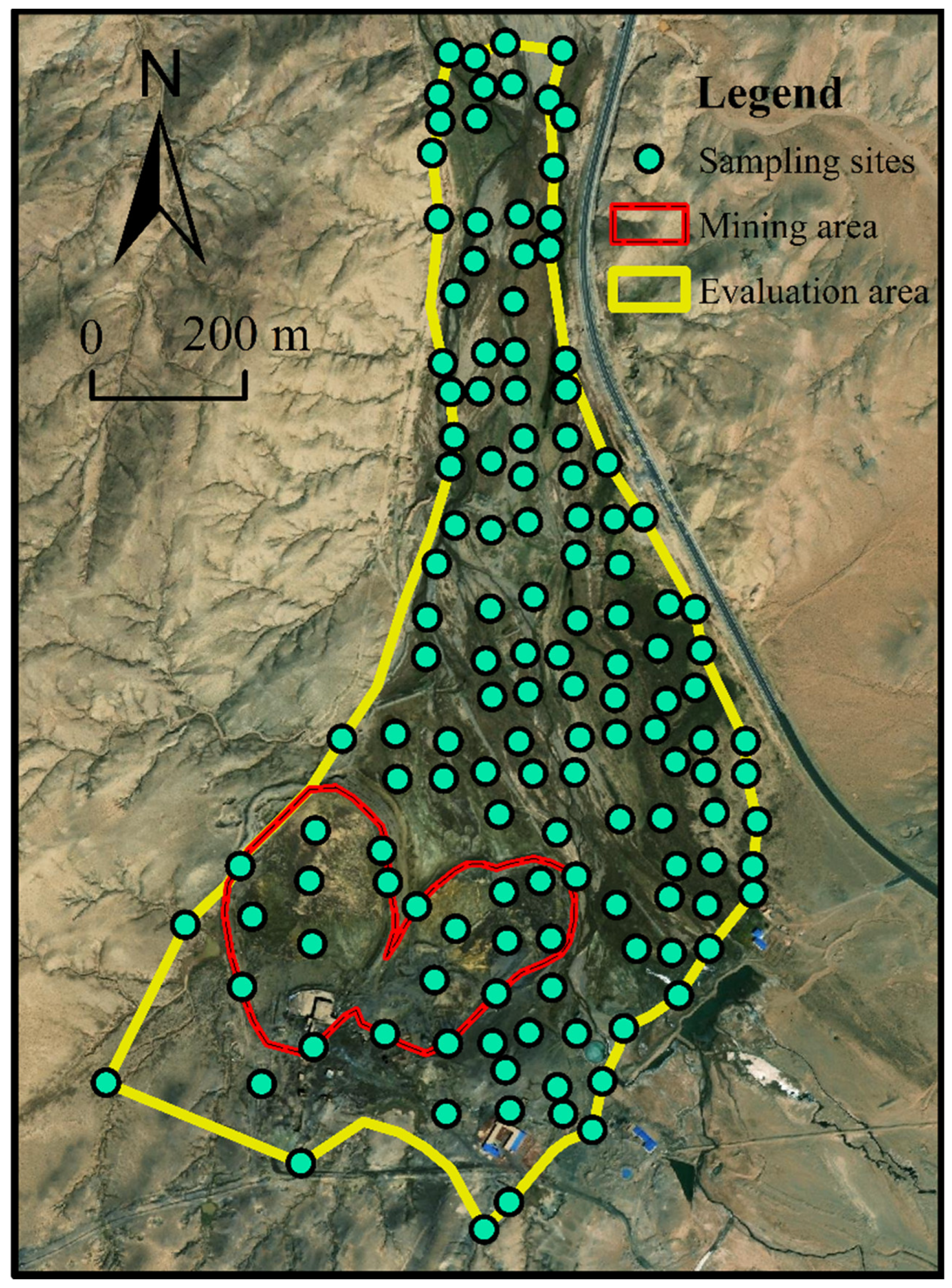
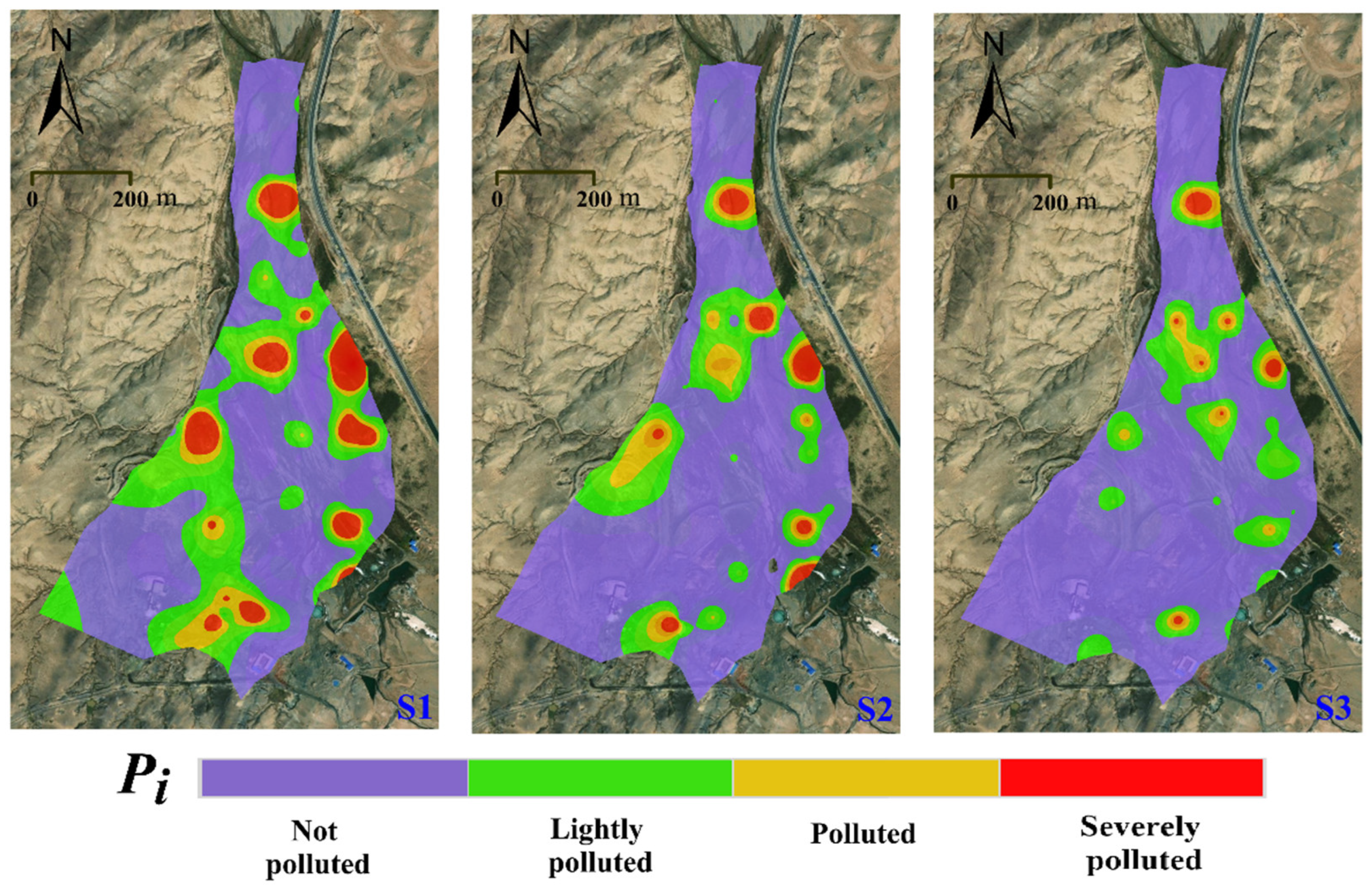
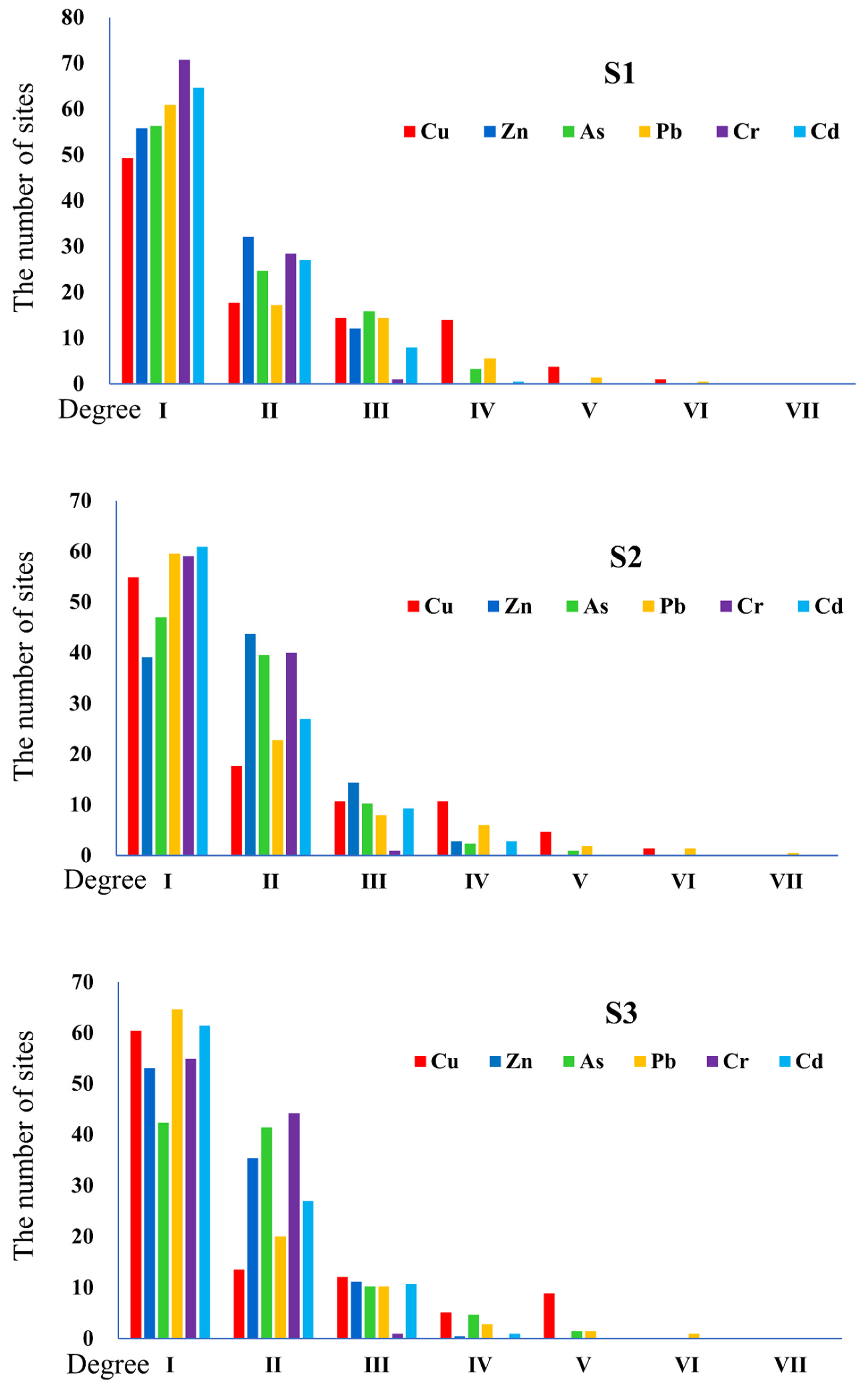
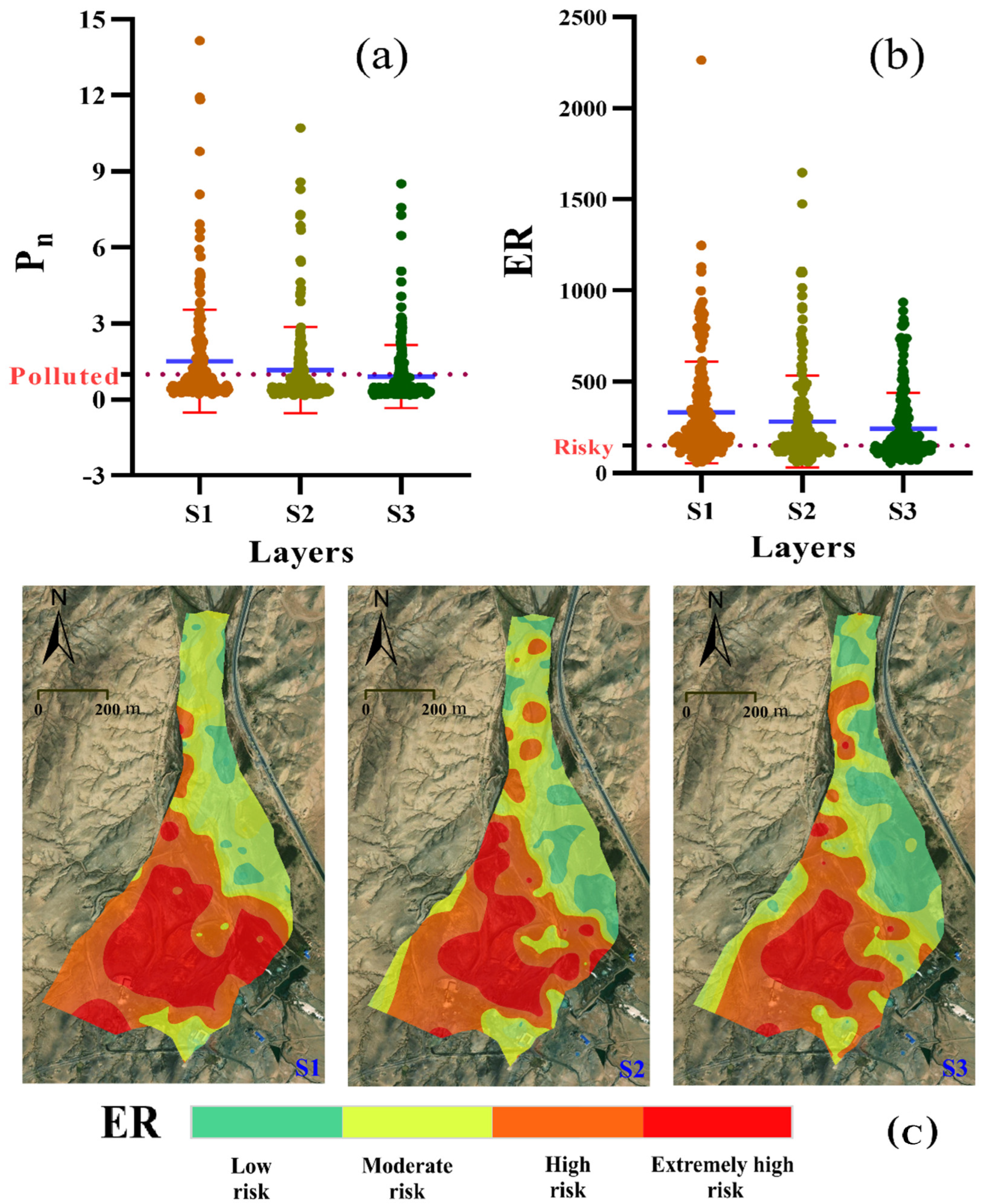

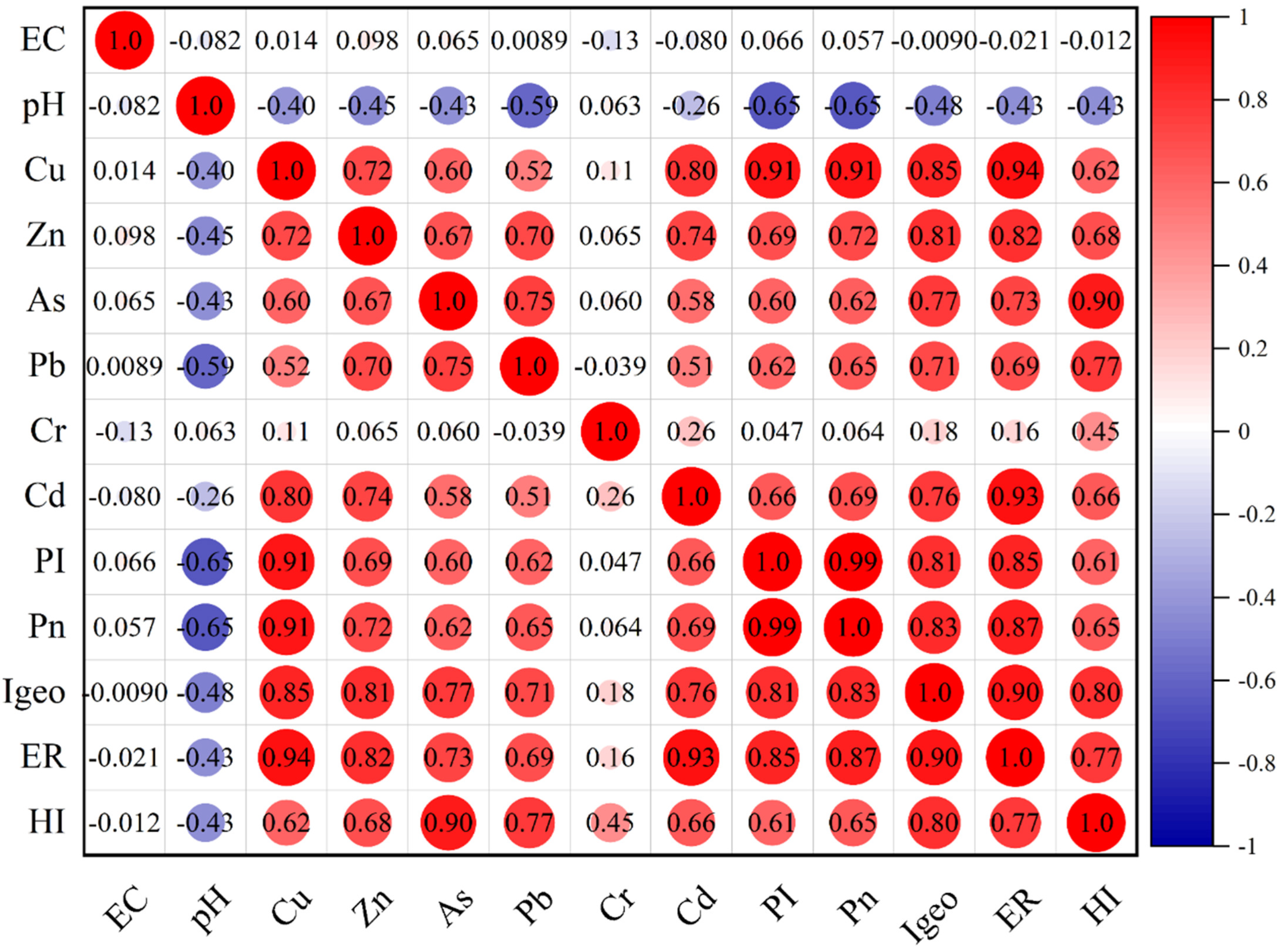
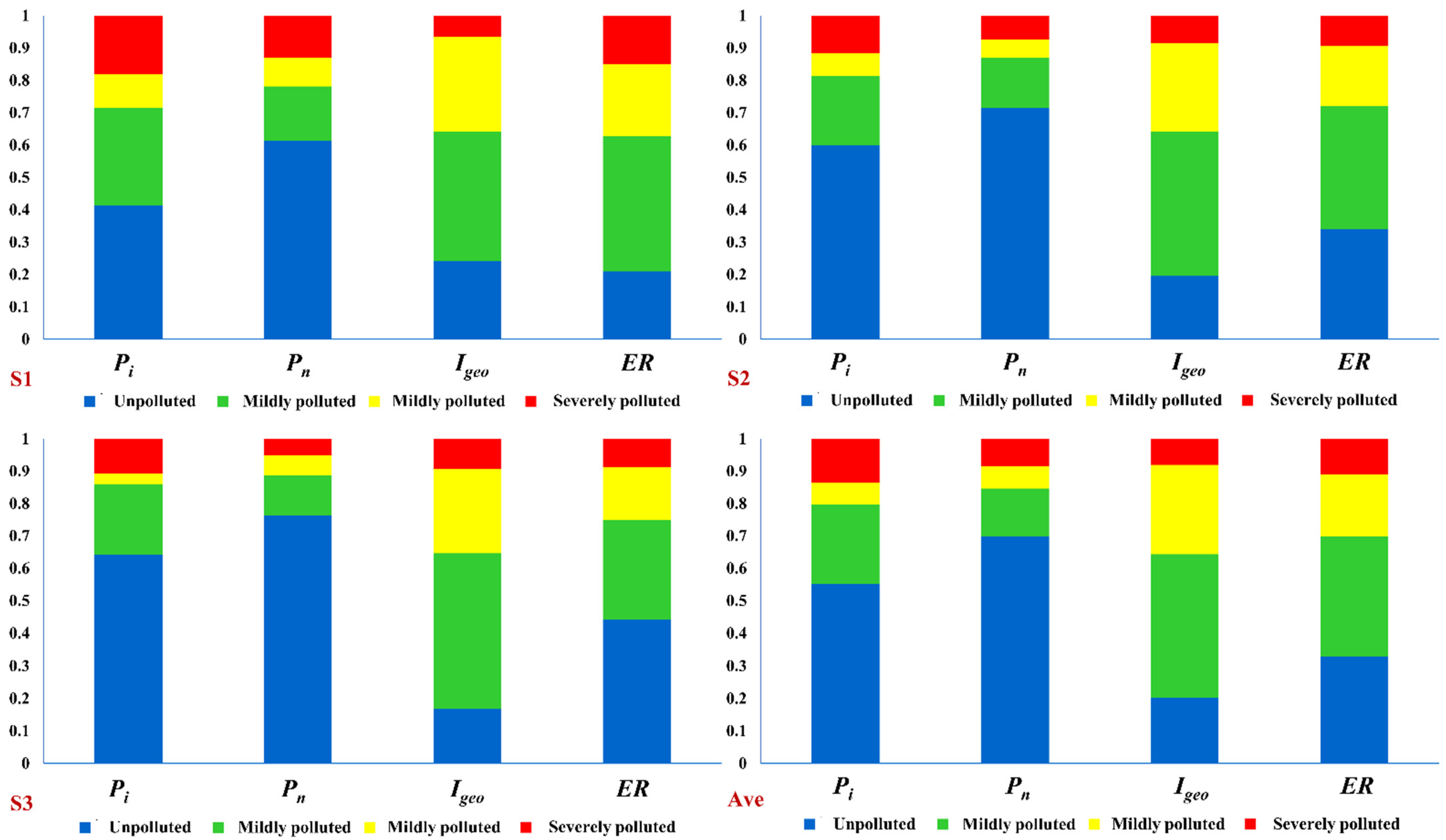
| Standard Items | pH | Cu | Zn | As | Pb | Cr | Cd |
|---|---|---|---|---|---|---|---|
| Risk screening values | pH ≤ 5.5 | 50 | 200 | 40 | 70 | 150 | 0.3 |
| 5.5 < pH ≤6.5 | 50 | 200 | 40 | 90 | 150 | 0.3 | |
| 6.5 < pH ≤7.5 | 100 | 250 | 35 | 120 | 200 | 0.3 | |
| 7.5 < pH | 100 | 300 | 25 | 170 | 250 | 0.6 | |
| Risk intervention values | pH ≤ 5.5 | - | - | 200 | 400 | 800 | 1.5 |
| 5.5 < pH ≤ 6.5 | - | - | 150 | 500 | 850 | 2.0 | |
| 6.5 < pH ≤ 7.5 | - | - | 120 | 700 | 1000 | 3.0 | |
| 7.5 < pH | - | - | 100 | 1000 | 1300 | 4.0 |
| Metals | Layers | Max (mg/kg) | Min (mg/kg) | Median (mg/kg) | Mean (mg/kg) | SD | CV (%) |
|---|---|---|---|---|---|---|---|
| Cu | S1 | 2954 | 12 | 131 | 272 | 362.39 | 133.39 |
| S2 | 1917 | 5 | 76 | 189 | 292.19 | 154.21 | |
| S3 | 1122 | 4 | 53 | 151 | 224.09 | 148.35 | |
| Zn | S1 | 350 | 16 | 82 | 102 | 57.69 | 56.45 |
| S2 | 355 | 9 | 67 | 86 | 56.13 | 65.41 | |
| S3 | 282 | 8 | 65 | 76 | 44.64 | 58.42 | |
| As | S1 | 89 | 0.2 | 12 | 18 | 15.45 | 84.57 |
| S2 | 139 | 0.3 | 10 | 13 | 13.42 | 104.86 | |
| S3 | 85 | 0.1 | 10 | 12 | 11.74 | 95.10 | |
| Pb | S1 | 1134 | 6 | 53 | 103 | 130.07 | 126.72 |
| S2 | 1945 | 4 | 41 | 97 | 205.36 | 211.35 | |
| S3 | 821 | 1 | 39 | 66 | 98.37 | 149.63 | |
| Cr | S1 | 193 | 12 | 53 | 56 | 23.38 | 42.11 |
| S2 | 187 | 13 | 60 | 58 | 25.26 | 43.21 | |
| S3 | 121 | 15 | 54 | 55 | 22.69 | 40.99 | |
| Cd | S1 | 1.60 | 0.05 | 0.20 | 0.25 | 0.18 | 69.80 |
| S2 | 1.08 | 0.03 | 0.18 | 0.24 | 0.18 | 77.03 | |
| S3 | 1.12 | 0.03 | 0.16 | 0.22 | 0.17 | 77.57 |
| Soil Layers | Cu | Zn | As | Pb | Cr | Cd |
|---|---|---|---|---|---|---|
| S1 | 101.89 | 78.44 | 12.42 | 58.37 | 57.94 | 0.23 |
| S2 | 75.18 | 54.54 | 8.83 | 44.84 | 57.69 | 0.19 |
| S3 | 63.98 | 60.52 | 7.33 | 42.18 | 50.66 | 0.17 |
Publisher’s Note: MDPI stays neutral with regard to jurisdictional claims in published maps and institutional affiliations. |
© 2022 by the authors. Licensee MDPI, Basel, Switzerland. This article is an open access article distributed under the terms and conditions of the Creative Commons Attribution (CC BY) license (https://creativecommons.org/licenses/by/4.0/).
Share and Cite
Teng, Y.; Liu, L.; Zheng, N.; Liu, H.; Wu, L.; Yue, W. Application of Different Indices for Soil Heavy Metal Pollution Risk Assessment Comparison and Uncertainty: A Case Study of a Copper Mine Tailing Site. Minerals 2022, 12, 1074. https://doi.org/10.3390/min12091074
Teng Y, Liu L, Zheng N, Liu H, Wu L, Yue W. Application of Different Indices for Soil Heavy Metal Pollution Risk Assessment Comparison and Uncertainty: A Case Study of a Copper Mine Tailing Site. Minerals. 2022; 12(9):1074. https://doi.org/10.3390/min12091074
Chicago/Turabian StyleTeng, Yanguo, Linmei Liu, Nengzhan Zheng, Hong Liu, Lijun Wu, and Weifeng Yue. 2022. "Application of Different Indices for Soil Heavy Metal Pollution Risk Assessment Comparison and Uncertainty: A Case Study of a Copper Mine Tailing Site" Minerals 12, no. 9: 1074. https://doi.org/10.3390/min12091074
APA StyleTeng, Y., Liu, L., Zheng, N., Liu, H., Wu, L., & Yue, W. (2022). Application of Different Indices for Soil Heavy Metal Pollution Risk Assessment Comparison and Uncertainty: A Case Study of a Copper Mine Tailing Site. Minerals, 12(9), 1074. https://doi.org/10.3390/min12091074







